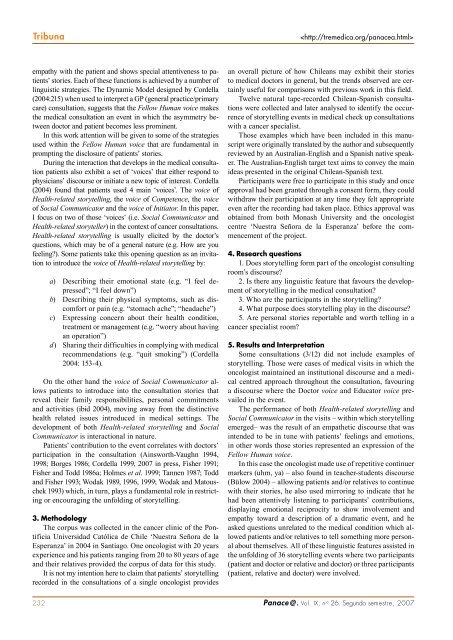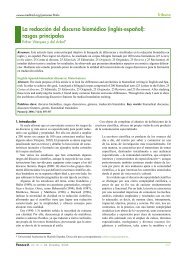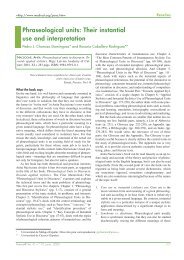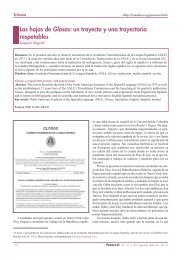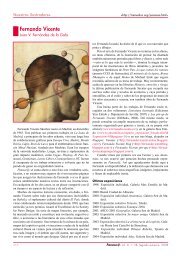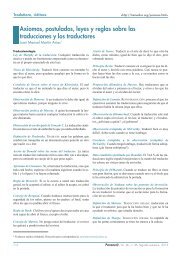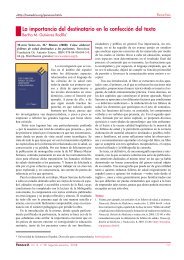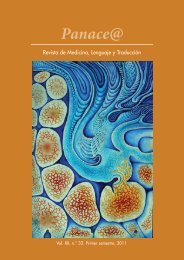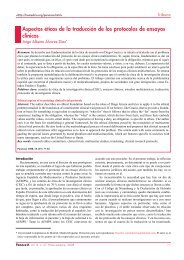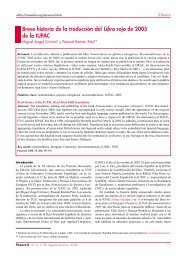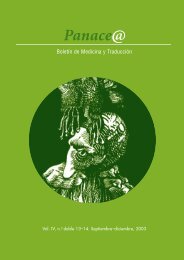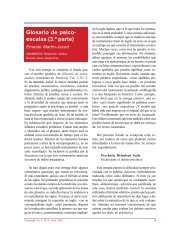Panace@ 26. Diciembre del 2007 - Tremédica
Panace@ 26. Diciembre del 2007 - Tremédica
Panace@ 26. Diciembre del 2007 - Tremédica
Create successful ePaper yourself
Turn your PDF publications into a flip-book with our unique Google optimized e-Paper software.
Tribuna<br />
<br />
empathy with the patient and shows special attentiveness to patients’<br />
stories. Each of these functions is achieved by a number of<br />
linguistic strategies. The Dynamic Mo<strong>del</strong> designed by Cor<strong>del</strong>la<br />
(2004:215) when used to interpret a GP (general practice/primary<br />
care) consultation, suggests that the Fellow Human voice makes<br />
the medical consultation an event in which the asymmetry between<br />
doctor and patient becomes less prominent.<br />
In this work attention will be given to some of the strategies<br />
used within the Fellow Human voice that are fundamental in<br />
prompting the disclosure of patients’ stories.<br />
During the interaction that develops in the medical consultation<br />
patients also exhibit a set of ‘voices’ that either respond to<br />
physicians’ discourse or initiate a new topic of interest. Cor<strong>del</strong>la<br />
(2004) found that patients used 4 main ‘voices’. The voice of<br />
Health-related storytelling, the voice of Competence, the voice<br />
of Social Communicator and the voice of Initiator. In this paper,<br />
I focus on two of those ‘voices’ (i.e. Social Communicator and<br />
Health-related storyteller) in the context of cancer consultations.<br />
Health-related storytelling is usually elicited by the doctor’s<br />
questions, which may be of a general nature (e.g. How are you<br />
feeling?). Some patients take this opening question as an invitation<br />
to introduce the voice of Health-related storytelling by:<br />
a) Describing their emotional state (e.g. “I feel depressed”;<br />
“I feel down”)<br />
b) Describing their physical symptoms, such as discomfort<br />
or pain (e.g. “stomach ache”; “headache”)<br />
c) Expressing concern about their health condition,<br />
treatment or management (e.g. “worry about having<br />
an operation”)<br />
d) Sharing their difficulties in complying with medical<br />
recommendations (e.g. “quit smoking”) (Cor<strong>del</strong>la<br />
2004: 153-4).<br />
On the other hand the voice of Social Communicator allows<br />
patients to introduce into the consultation stories that<br />
reveal their family responsibilities, personal commitments<br />
and activities (ibid 2004), moving away from the distinctive<br />
health related issues introduced in medical settings. The<br />
development of both Health-related storytelling and Social<br />
Communicator is interactional in nature.<br />
Patients’ contribution to the event correlates with doctors’<br />
participation in the consultation (Ainsworth-Vaughn 1994,<br />
1998; Borges 1986; Cor<strong>del</strong>la 1999, <strong>2007</strong> in press, Fisher 1991;<br />
Fisher and Todd 1986a; Holmes et al. 1999; Tannen 1987; Todd<br />
and Fisher 1993; Wodak 1989, 1996, 1999; Wodak and Matouschek<br />
1993) which, in turn, plays a fundamental role in restricting<br />
or encouraging the unfolding of storytelling.<br />
3. Methodology<br />
The corpus was collected in the cancer clinic of the Pontificia<br />
Universidad Católica de Chile ‘Nuestra Señora de la<br />
Esperanza’ in 2004 in Santiago. One oncologist with 20 years<br />
experience and his patients ranging from 20 to 80 years of age<br />
and their relatives provided the corpus of data for this study.<br />
It is not my intention here to claim that patients’ storytelling<br />
recorded in the consultations of a single oncologist provides<br />
an overall picture of how Chileans may exhibit their stories<br />
to medical doctors in general, but the trends observed are certainly<br />
useful for comparisons with previous work in this field.<br />
Twelve natural tape-recorded Chilean-Spanish consultations<br />
were collected and later analysed to identify the occurrence<br />
of storytelling events in medical check up consultations<br />
with a cancer specialist.<br />
Those examples which have been included in this manuscript<br />
were originally translated by the author and subsequently<br />
reviewed by an Australian-English and a Spanish native speaker.<br />
The Australian-English target text aims to convey the main<br />
ideas presented in the original Chilean-Spanish text.<br />
Participants were free to participate in this study and once<br />
approval had been granted through a consent form, they could<br />
withdraw their participation at any time they felt appropriate<br />
even after the recording had taken place. Ethics approval was<br />
obtained from both Monash University and the oncologist<br />
centre ‘Nuestra Señora de la Esperanza’ before the commencement<br />
of the project.<br />
4. Research questions<br />
1. Does storytelling form part of the oncologist consulting<br />
room’s discourse?<br />
2. Is there any linguistic feature that favours the development<br />
of storytelling in the medical consultation?<br />
3. Who are the participants in the storytelling?<br />
4. What purpose does storytelling play in the discourse?<br />
5. Are personal stories reportable and worth telling in a<br />
cancer specialist room?<br />
5. Results and Interpretation<br />
Some consultations (3/12) did not include examples of<br />
storytelling. Those were cases of medical visits in which the<br />
oncologist maintained an institutional discourse and a medical<br />
centred approach throughout the consultation, favouring<br />
a discourse where the Doctor voice and Educator voice prevailed<br />
in the event.<br />
The performance of both Health-related storytelling and<br />
Social Communicator in the visits – within which storytelling<br />
emerged– was the result of an empathetic discourse that was<br />
intended to be in tune with patients’ feelings and emotions,<br />
in other words those stories represented an expression of the<br />
Fellow Human voice.<br />
In this case the oncologist made use of repetitive continuer<br />
markers (uhm, ya) – also found in teacher-students discourse<br />
(Bülow 2004) – allowing patients and/or relatives to continue<br />
with their stories, he also used mirroring to indicate that he<br />
had been attentively listening to participants’ contributions,<br />
displaying emotional reciprocity to show involvement and<br />
empathy toward a description of a dramatic event, and he<br />
asked questions unrelated to the medical condition which allowed<br />
patients and/or relatives to tell something more personal<br />
about themselves. All of these linguistic features assisted in<br />
the unfolding of 36 storytelling events where two participants<br />
(patient and doctor or relative and doctor) or three participants<br />
(patient, relative and doctor) were involved.<br />
232 <strong>Panace@</strong>. Vol. IX, n .o <strong>26.</strong> Segundo semestre, <strong>2007</strong>


